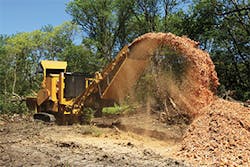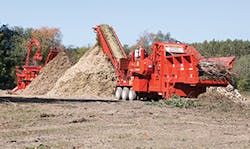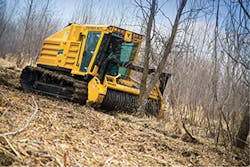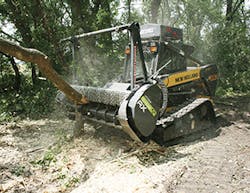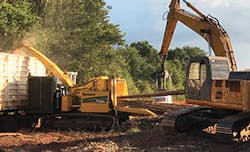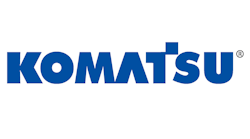As useful as grinders and shredders are, they’ll never operate to their maximum efficiency if contractors don’t first select the right versions of these machines for their job sites.
Every job site is different, and every job is different. Some jobs might call for the removal of a thick blanket of brush in a heavily wooded area. Other job sites might be dotted with thick tree stumps. Finding the right machine for each job site is a key move for those contractors who want to clear sites as quickly and efficiently as possible.
Contractors should want their land-clearing work to move smoothly. Land-clearing is the first job in many grading and excavation projects. If contractors can clear their sites with as little stress and extra work as possible, they’ll be taking the first steps to completing entire projects on time and on budget.
Fortunately, there are hacks that contractors can rely on to lessen the time it takes to clear land. It’s all about choosing not only the right machine but the right attachments to go with it. It’s also about analyzing the material that contractors need to clear and determining what, if any, additional use contractors might have for the ground and mulched material that is cleared from a job site.
Morbark 1300 Tub Grinder
Taking the Time to Prepare
Jeff Bradley, product manager for recycling and forestry equipment with Pella, IA-based Vermeer, says that contractors who don’t analyze their job sites before bringing along grinders and shredders will only cost themselves time and money. Bradley says that contractors should first determine the volume of land that needs to be cleared and then work with their local dealers to find the right-sized machine to complete this job in the least amount of time.
“Understanding what type of materials will either be cleared or processed is key to defining the right machine,” according to Bradley.
If contractors, for example, will be processing whole trees, then they should choose a horizontal grinder or whole-tree chipper. But contractors who are hired to log out the trees and just grind up root balls would do better to choose a tub grinder. This type of grinder would be more efficient because contractors will have to do less prep work on the material they are grinding.
Contractors need to determine if their job requires tracked or trailered machines, too. That will depend largely on the terrain of their job sites. Contractors also need to look at the final destination for the material they are clearing. Will they leave the grinded material onsite? Or will they be hauling the ground material to a mulch supplier? Will the material they are clearing eventually be used as fuel chips?
The answers to these questions will help determine whether contractors should use a forestry mulcher (if the material is to remain at the site in a ground-up form), grinder, or whole tree chipper. The latter two choices are good options for jobs in which materials will be transported and used as mulch or fuel chips.
Bradley says, too, that contractors need to look at the support equipment they already own. This support equipment must be sized properly to support whatever new grinder contractors are using on a job.
“As an example, you will not be able to utilize a 1,000-horsepower grinder if you only have a 200 series excavator,” explains Bradley.
For Tyler Zima, product attachment specialist with Bobcat, the versatility of shredders and grinders makes them important tools for contractors, whether these contractors invest in their own equipment or work with subcontractors who specialize in land-clearing work.
Attachments make grinders and shredders even more versatile. But this versatility can be a hindrance. Contractors who don’t use the right machines for the right jobs will, instead of boosting their efficiency, lower it. There is no reason, for example, for contractors to use a forestry cutter attachment if they are only cutting down small trees and brush.
“There are so many different options with these machines,” says Zima. “You can use the forestry cutter attachment to take down large trees or a lot of trees. It’s important to choose the right attachment.”
Zima says that clearing a site of trees, brush, and stumps is a fairly simple task. But contractors do need the right attachments and machines for the job.
To clear land as quickly as possible? Contractors must first prep their machines and attachments, mating them correctly.
“Do you need standard-flow or high-flow? Do you have the machine that will make that attachment as efficient as possible? Can you run the machine at the correct speed? If you overload your machine, the blades, then, won’t move as fast,” says Zima. “It’s the same thing with forestry cutters. You can run it until it stalls. But you shouldn’t do that. You need to read the owner’s manual to understand the correct operation of these machines.”
Loftness Battle Ax
Do the Work or Hire It Out?
Michael Stanton, director of industrial product with Winn, MI-based Morbark, says that larger contractors can save money and time on site clearing by working with smaller companies that specialize in grinding and shredding work.
This could be considered a key site-clearing hack for certain contractors: instead of investing in their own equipment and training their own operators, grading and excavation contractors can hire out the work to subcontractors who already have the necessary equipment and trained labor force to handle the job.
“They can work with a third-party provider who does this work,” points out Stanton. “If that outside provider is reliable and skilled, this can be a good solution for contractors who don’t want to get into the chipping, grinding, and clearing of debris.”
This isn’t the only approach, though, and isn’t always the right solution for some contractors. Others might choose to purchase their own grinders and shredders to make sure that they can take on site-clearing jobs quickly.
“It might be a time-sensitive job,” says Stanton. “Instead of waiting on an outside contractor, they’ll already have the equipment to do it. They can then work around their own schedule. You have two different approaches that can both work for different reasons.”
The Vermeer FT300 in action
Those contractors that choose to invest in grinders and shredders can realize a financial benefit.
First, grinders and shredders reduce large piles of material into smaller, far more manageable piles. The reduction of original material to ground or shredded material can be as high as eight-to-one, Stanton says. It’s far easier for contractors, then, to transport this reduced material off the job site.
“In many cases, material does have to be hauled off,” says Stanton. “The contractors are looking for a size reduction to make that more affordable. The goal is to make the material piles as small as possible. If you can reduce it on an eight-to-one basis, that means you are hauling out one truckload of material instead of eight. That’s a big difference. That can greatly reduce your costs.”
At the same time, contractors who use the right grinding and shredding products can turn their site-clearing debris into usable, and sellable, products, Stanton says, which is another way for them to boost their yearly income.
Some material cleared off sites can be used as biomass to create energy. Other materials will be ground into mulch.
“Contractors can use these machines to take waste and turn it into useful products for additional revenue,” explains Stanton. “The people who run our grinders cater to two markets: land-clearing, of course, but also mulch operations. They are often accomplishing two tasks with the same set of machines.”
These factors, then, can help contractors determine if it makes more sense to form relationships with subs who specialize in grinding and shredding, or if they can realize enough of an income and efficiency boost to invest in their own set of site-clearing machines.
Prepping the Site, a Key Hack
Running grinders efficiently also requires a bit of prep work, according to Bradley. Contractors who take the time to prepare the material to be ground before starting work will find that they can complete jobs at a much faster and more affordable clip.
“To be able to use a grinder efficiently means having the material prepared correctly to match the ability of the grinder so you do not have to manipulate the material as you are trying to feed it into the grinder,” says Bradley.
Not doing daily maintenance and not properly preparing materials on a job site are the two most common mistakes that operators make when running grinders or shredders. Some contractors also make the mistake of using the wrong shredder or grinder for the materials they need to clear.
“Having the material prepared to match the capabilities of the grinder will make the job run as efficiently as possible,” preaches Bradley.
Stanton, too, points to prepping the site as one of the most important steps operators and contractors can take to boost their site-clearing efficiency.
He recommends that operators first shake off as much dirt from materials to be ground or shredded as possible before they start running their machines. This will allow a grinder’s teeth and chipper’s knives to work as efficiently as possible.
Next, operators should always have their material staged and ready for processing.
“So when you bring a machine, you are immediately ready to feed it,” offers Stanton. “You are making the whole operation more efficient. The materials are staged for the machine to come in and operate. The proactive staging of the material can make a site-clearing job move so much more quickly.”
Analyzing a job site before they start clearing will save contractors time and reduce frustration. For some jobs, contractors might already have the proper land-clearing tools in-house. For others, they might have to rent the right machine or work with a subcontractor.
But until contractors take a close look at their job sites, they won’t be able to make these decisions.
“A lot of what machine you should use depends on the material that is on that job site,” explains Zima. “If you are taking tall grass and light brush down, contractors should lean more toward a Brushcat rotary cutter attachment. The forestry cutter is for someone taking down large material in a very fast fashion. It really shreds the trees. It doesn’t mulch it into fine material. The decision on choosing machines and attachments comes down to what’s on the site and what they want do with the materials when they’re done.”
The most common mistake that Zima sees from grinder and shredder operators? They don’t maintain their machines properly and they don’t run them properly.
Too often, operators run standard-flow attachments with high-flow machines. That can result in catastrophic failures. Operators who do that can blow out their shredders’ and grinders’ motors.
Another common mistake? Contractors either don’t know which attachment to run with their land-clearing equipment, or they choose not to purchase an attachment that would make more sense for a job.
“If you want to take out a lot of large material, you don’t want to use a Brushcat attachment,” warns Zima. “That isn’t very efficient.”
Jason Archbold, marketing manager with Bobcat, says that operators who mate the wrong attachment with the wrong machine aren’t just lessening the efficiency of their land-clearing equipment. They might also be putting their own safety at risk.
The Vermeer WC2500TX
“If you have an improper mating between machine and equipment, you might not only damage the equipment, but the machines can also become unsafe,” continues Archbold. “If you are using a stump grinder or a forestry cutter, there will be a lot of debris flying around. If you do not have the right protective equipment on the machine, the operators can get injured. If operators are using a high-flow attachment on a standard-flow machine, you can blow pieces of equipment. The hydraulic flow that can leak because of this can be dangerous on the site.”
In good news for contractors, the manufacturers of grinders and shredders are improving the technology behind these machines, something that will make it easier for operators to complete land-clearing jobs in less time.
Bill Schafer, VM product development supervisor with Loftness, a maker of attachments for grinders, said in an earlier interview with Grading & Excavation Contractor that industry advancements mean that grinders are better today at cutting and grinding materials.
He points to the move toward sharpened blades as a replacement for carbide bits. These bits have long been the standard for grinders. Today, though, manufacturers are turning to sharpened blades as an alternative.
The blades are a smart alternative. They tend to cut material faster and result in finer work, leaving contractors with a cleaner finished product.
Carbide bits are still important, Schafer adds. Carbide bits are more durable and are good choices for grinding large amounts of material when contractors don’t care as much about the fineness of the resulting material. Carbide bits also require less maintenance. Contractors can replace them when they become worn out.
Morbark 3200
Track Wood Hog
Are Grinders and Shredders a Good Investment?
Not all contractors will make grinders or shredders part of their permanent fleets. It makes financial sense for some construction companies to hire subcontractors to take on the site-clearing work of their jobs.
Those contractors who have found solid subcontractors—those who aren’t late to their job sites and use grinders and shredders to clear the sites quickly and correctly—might be wise to stay with these subs. But those who have been disappointed with the site-clearing work done by their subcontractors might instead consider purchasing their own grinders and shredders.
After all, site-clearing is an important part of most grading and excavation jobs. Having their own machines can eventually save contractors money.
The only caveat . . . grinding is a bit of a specialty. New operators will need practice, and training, to become proficient at this skill.
“If your sub is late to get the job done or does not finish the way you need them to, then it might be time to invest in taking control of your own destiny,” advises Bradley. “Grinders are not complicated machines to run, but there is a learning curve of how to optimize its performance, so plan for a learning period before you will be truly efficient at grinding.”
Contractors also need to look at their overall workflow when determining whether to invest in grinders and shredders and, if they do decide to purchase this equipment, which size and type of grinding machines make the most sense for their businesses.
Some contractors can survive with smaller shredders and grinders, while others, depending on the type of jobs they usually take on, will do better to invest in machines with more power. Still others might decide on a mix of owned equipment and rented machines for particularly unusual jobs.
“Just because you are taking on one 50-acre job doesn’t mean that you always need the biggest possible machine,” explains Stanton. “Does that big machine fit into your overall business model if most of your jobs are five to 10 acres? You have to look at what your most common jobs are, and how that will impact which grinding machines you need.”
At the same time, contractors should consider the type of materials that they usually process. Contractors might occasionally have a large piece of wood that requires the grinding force of the largest and most powerful machine on the market.
But how often does this happen? Contractors who usually process smaller materials can get by with mid-size machines, and can then turn to a subcontractor, perhaps, to handle the rare piece of big wood.
WC2500TX Action
Maintenance Matters
Choosing the right grinder or shredder for a job is critical. But it’s equally important for contractors to take the steps necessary to keep their machines out of the repair shop and on the site.
The key to doing this lies in preventative maintenance.
Fortunately, today’s grinders and shredders don’t require an inordinate amount of maintenance. By following the recommendations of their machines’ owner’s manual and performing regular inspections of their machines, contractors and operators should be able to keep these tools in good health.
“Daily maintenance is the key to the longevity of the machine,” says Bradley. “One main area we’ve focused on in developing our newer grinders is the ease of maintenance factor. We want our customers to routinely maintain their machine to ensure maximum uptime. To help this happen, we’ve made maintenance easier.”
That is common sense, and something all operators and contractors should embrace. Not all do, but they should. But there’s another tip that Bradley offers: contractors who are sending their grinders and shredders to contaminated sites should equip their machines with metal-prevention systems.
Vermeer offers its own such system, Damage Defense. Such metal-prevention systems help reduce the chances that grinders or shredders will suffer the serious damage that can result when a contaminant metal enters their mills. Systems such as Damage Defense will identify the metal when it first hits the mill, while the metal is still in the infeed. If the system detects this metal, the machine will shut down, giving the operator the chance to remove the metal before continuing with the work.
Contractors who invest in this sort of protection can save significant dollars in repair costs. Just as importantly, they can reduce the amount of time that their shredders and grinders are wasting in repair bays instead of mulching up materials on the job site.
Such preventative maintenance measures are the true key to an efficient work site.
“I have suggested to numerous operators and owners that they actually wash their machines once in a while to be able to see the issues before they become costly issues resulting in on-the-job downtime,” says Bradley.
This type of preventative maintenance should never be ignored, even when contractors have little reason to believe that trouble is ready to hit their machines.
“Even when your machines are running at an optimal level, you always want to check,” advises Stanton.
In a grinder, operators and owners should check a machine’s inserts on a daily basis. For a chipper, they should check the chipper knives regularly.
And if there are any signs of wear, even just a little, contractors should replace the parts.
“Even if it seems not completely wore down, be proactive and change it,” says Stanton. “That will you give a consistent operating cost, a consistent efficiency. If you run a machine too long with worn parts, it will run worse. It offsets all the good things, all the other preventative maintenance that you’ve done.”